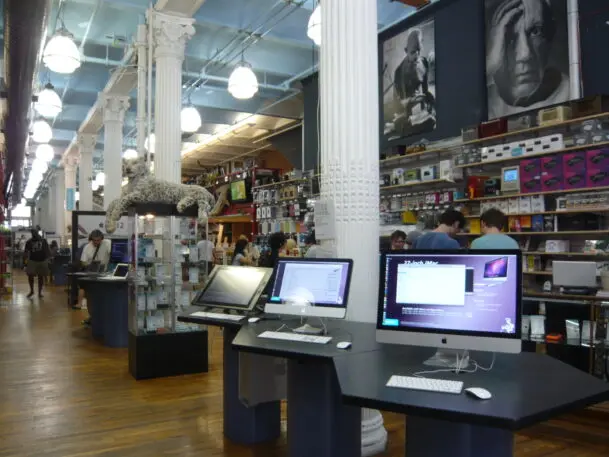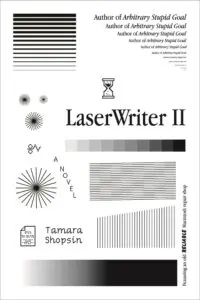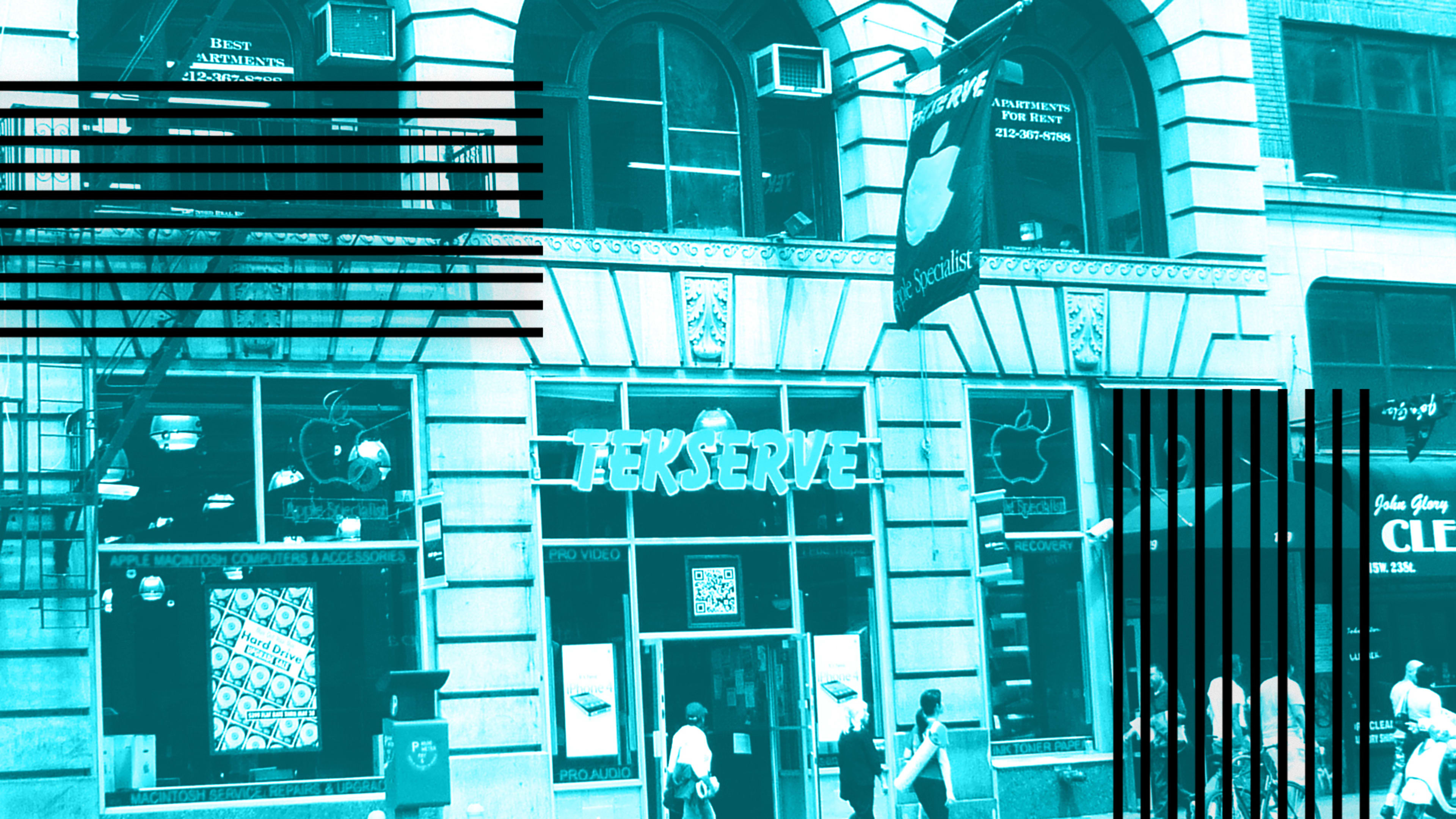Perhaps it was inevitable, growing up in a family restaurant that had a menu legendary for its unbelievable length, that Tamara Shopsin would find herself drawn to endless printed pages. Her new novel, LaserWriter II, is a work of love and beauty, with quirks and twists, following its slightly autobiographical printer-repairing protagonist’s time at Tekserve, an Apple equipment repair shop in Manhattan that thrived from the late 1980s until the age of Apple’s own retail presence. (Cupertino started up its photocopiers, and blurry reproductions of Tekserve and other independent repair shops flooded out, as Genius Bars.)
The book will cause aching nostalgia for readers of the right generation: those who remember opening up computers or taking them to people with the know-how, those who recall PageMaker 1.0 or QuarkXPress 3.0 and the joy of refilling toner cartridges oh so carefully, and those who wore an anti-static strap to avoid frying computer chips.
For a younger crowd, the story is compelling, and the details will read quaintly historically in a way that, when I think about it, turns my bones to dust, and I blow away.
The phrase an Apple repair shop doesn’t begin to accurately describe Tekserve. It was the repair shop for a good chunk of its three decades. It was extraordinary across many axes, including the staff’s ability to repair just about everything and refusal to charge for phone support and quite a lot else. Shopsin told me that it was also an incredibly kind place.

Kenny threw a lot of people out of Shopsin’s—one party a day, he once estimated—for transgressions, such as being a party of more than four or wearing neckties. He would swear. He lied to customers about being closed if he didn’t want to serve them. Tekserve’s owners and founders, Dick Demenus and David Lerner, took quite a different approach. “Dick and David were just so kind,” Shopsin said. “The goal was to get the customer out of there with their problems fixed—not spending money. I feel like anybody that used a Mac in New York City at that time ended up in Tekserve. And the heavens opened up with happiness when they found it.”

We get glimpses of this beauty throughout the novel, and later variants and bigger siblings. Shopsin’s love of this model isn’t unique among folks who grew up or worked in offices across this period. The LaserWriter II let us try things out, produce beautiful work, and get things done. It could also produce monstrously ugly flyers and newsletters, but none of us blamed the printer.
Accidental fiction
That LaserWriter II is a novel is almost an accident. “When I set out, I thought this would be a nonfiction book, because honestly, I’ve never done fiction,” says Shopsin. “And it just turned into this. Tekserve is really important. It’s deep in my heart.” Shopsin asked for Demenus and Lerner’s blessings for the book as a work of non-fiction, and then again when it veered fictional. She interviewed a number of former Tekserve employees, thanked by their work-order initials in the acknowledgements.
The book follows Claire, a teenager who happens upon Tekserve and is quickly hired. She is painfully introverted, but takes to repair intuitively, and is quickly promoted to working on printers. Shopsin makes it clear she wasn’t exactly Claire on the inside, but she filters versions of her three months at Tekserve in the late 1990s through Claire’s impressions.
As the novel explains, Tekserve’s policy for printer repairs is to print an impossible 100 test pages to ensure the printer is fit before its return to a customer. I was shocked by the profligacy: Toner was expensive then! So was paper! But this was all in the service of the customer. The novel’s layout echoes this endless waterfall of output, leaving huge areas of white space at the bottoms of pages where the novel’s rhythm calls for it.
Claire becomes expert at repairing printers. A slower printer-repair coworker shifts from passive-aggressive to mildly aggressive as Claire improves. An ex-employee who is a whiz at repairing output devices bestows unwanted, slightly creepy attention on her. She watches employees come and go—none are fired, but some quit or leave when they recognize their own inadequacy. She makes a mistake for which she can’t quite forgive herself.

LaserWriter II is a good, fast read. In certain places, it also uses a narrative device I found absolutely unique and surprising. Shopsin asked me to keep it secret, so it’s fresh for her readers.
So let’s talk about Shopsin’s General Store’s menu for a minute. It’s not a character in the novel, but it was well acquainted with LaserWriter IIs and beyond. It had 900 items on its 6 sheets. The diner sat 34. There was no takeout permitted. In 2008, Kenny told the New York Times, “I spent almost $3,000 on toner in the last three months.” Maybe the restaurant ran on toner as much as on the creative intensity of its owners and five children.
Eve died in May 2003; Kenny in September 2018. The current menu is somewhat shorter. Shopsin’s now lets people order take-out. Tamara’s brother Zack cooks every day the restaurant is open; she and her sister Melinda cook on the weekends.
“The store has a different vibe now, mostly because Zack is a sweetheart, but it is still a very special place that regularly gives me goosebumps,” Shopsin writes in an email. “Cooking with my brother is a great & pure joy.” In LaserWriter II’s acknowledgements, she thanks her brothers and sisters “for letting me have all of dad’s toner after he died.” Her favorite printer is, naturally, the LaserWriter II, though she has owned a Xerox and now has an HP.
Shopsin’s primary careers are as a graphic designer and illustrator. She avoids Twitter intentionally (and wisely). Her work can be found on her Instagram account, however, and as tiny bitmap chapter dividers in the book. It also appears in The New Yorker in the form of small thematic illustrations that appear throughout each issue. One week, they were fish whose bodies were partly made of pasta. (Yes, The New Yorker fact-checked her pasta-fish: “They told me, ‘Your tile fish needs another fin.'”)
I never managed a trip to Tekserve, though I’d heard about it from the outpost of Kodak I worked at in Maine in the early ’90s. I kept 100 Macintosh IIfx’s and early scanners and printers running far from repair shops. We had many New Yorkers step through our doors, and they all talked about Tekserve. It seemed mythological.
But a friend in publishing did take me to Shopsin’s, an institution that remained incomprehensible to me until I read Calvin Trillin’s account in The New Yorker several years later. (Kenny cooperated with it because the restaurant was about to move locations.) I was flabbergasted by the menu. How could they possibly have enough ingredients on hand to make this many distinct items? I liked the food just fine, and I was told by my friend I was in an institution. I don’t remember Kenny getting angry at anyone.
That Shopsin’s is no longer. (The current incarnation, and oversize menu, is located in the historic Essex Market on New York’s Lower East Side.) And Apple doomed Tekserve when Steve Jobs decided Apple needed to own in-person repairs. Shopsin notes in the fictional account of LaserWriter II that Apple asked to observe Tekserve’s operations as an authorized repair center, and then abruptly tightened the figurative screws by requiring more hardware be sent to Apple for repair and reimbursing less for work done on site. That’s not fiction.
The Genius Bar in the early Apple Stores was clearly modeled after Tekserve and other independent shops, though Apple’s bars were as corporate chilly as the rest of the company’s austere design philosophy. A Genius was knowledgeable. A Genius wasn’t necessarily kind.
Eventually, Apple got rid of Genius Bars in favor of free-range tech support in its stores. It shed easy repairs for Macs years ago, while iPhones and iPads were never designed to be fixed. Tekserve shut down in 2016, by then a shadow of itself.
Shopsin’s LaserWriter II captures an extended moment under amber (or perhaps under beige) and brought old memories back to the fore for me, and a few streaks of toner down my cheeks.
Recognize your brand’s excellence by applying to this year’s Brands That Matter Awards before the early-rate deadline, May 3.
